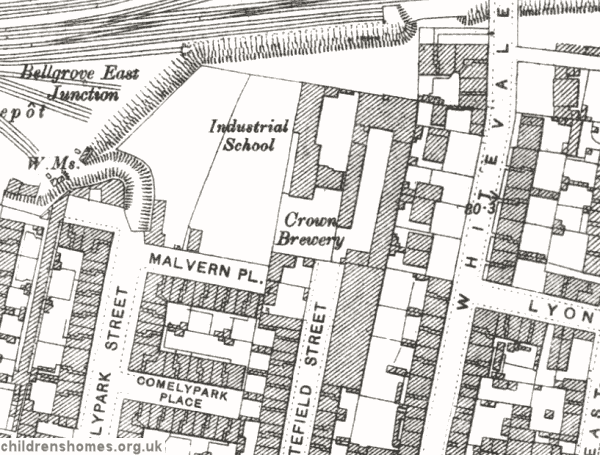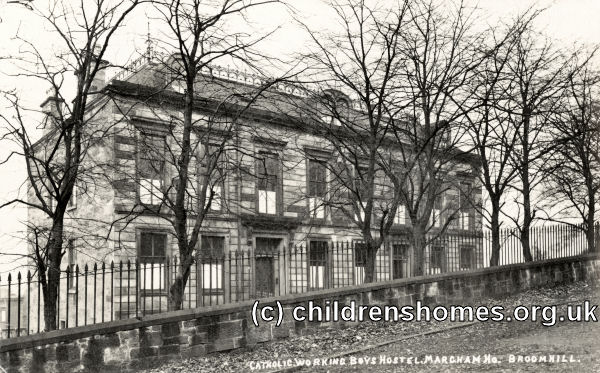Slatefield Industrial School for Roman Catholic Boys, Glasgow, Lanarkshire, Scotland
On 14 December 1867, the Slatefield (or Slatefields) Industrial School for Roman Catholic Boys was certified for operation at Slatefield House, 707 Gallowgate Street, Glasgow, with accommodation for around 100 boys aged from 10 to 15 years. The access route to the establishment changed over the years and its address was subsequently given as 719 Gallowgate Street, and then as 49 Slatefield Street. The School's first superintendent was Mr J. McCulloch, who had previously run the Catholic Boys' Orphanage on Abercromby Street, from where about 50 boys were transferred into his charge. Mrs McCulloch as the School's matron. The schoolmaster was Mr Clarke.
At first, the boys' industrial training consisted only of tailoring and matchbox-making. By 1872, some of the older boys were regularly employed on a half-time basis in a nearby rope manufactory. Mr Clarke was now assisted by Ignatius and Patrick McCulloch.
Mr McCulloch died at the end of 1876 and the running of the School came under the direct control of the chief Roman Catholic authorities in Glasgow. Mr and Mrs James McKean were appointed as superintendent and matron, with Mr Patrick McQuaid as as school teacher. Over the following two years, considerable alterations and additions were made to the premises and the new buildings came into operation on 24 October 1879. The School could now house 150 boys. Shoemaking was added to the list of industrial occupations.
New workshops, a covered playshed, and outside conveniences were erected in 1886. Twenty boys were now employed in the tailoring department, 18 in the shoemaking, and 12 in the paper-bag making. Forty boys were employed in a neighbouring rope walk, 20 each day. A junior class made and mended the socks, and repaired clothing. Some boys were employed in the kitchen and did the general work of the house. A brass band had been started and a bandmaster attended occasionally. The superintendent and matron were now Mr and Mr Charles Stuart who remained in charge until 1892. They were then succeeded by Mr and and Mrs T.E. Maley.
An 1896 inspection report noted that originally, the old private house which formed part of the frontage was the only accommodation the school had, with plenty of open space on all sides. Following the addition of wings of dormitories, etc., the School now stood at the end of a side cul de sac in the midst of a slummy district with a brewery on one side and still more unpleasant neighbours on the others. There was a small plot of ground in front where a few poultry and rabbits were kept. Classroom performance in composition, recitation, geography, mental arithmetic and grammar were generally rated as 'very fair'. Singing was taught by ear in the schoolroom and by means of the tonic sol-fa by the superintendent and matron out of school hours. There were now 20 tailors, 24 shoemakers, 20 bag makers, 36 knitters, 16 washhouse boys, and 35 in school full time. Working at rope-making was discontinued in 1895. The superintendent drilled the boys every morning, and extension motions to music had been gone through occasionally. The play-yard, part of which was covered, was said to be gloomy, and confined. About 40 boys could swim, occasional use being made of the public baths. There were generally two or three visits a week in summer and one a week in the winter to an athletic ground close by, for outside games. There was keen interest in football, the superintendent himself having been a player of some fame. The number of outside matches would have been much more numerous if the School's facilities were better. There was a good stock of readable books, and indoor games were supplied. Weekly lantern entertainments and occasional concerts etc. were given in the winter. The whole school had camped out for a week at the seaside, much to the improvement of the general health.
The School site is shown on the 1896 map below.

Slatefield Industrial School for Roman Catholic Boys site, Glasgow, c.1896.
In the summer of 1897, the School camped out for a month on the island of Cumbrae. Visits were now often arranged to see matches and sports at Celtic Park. In 1898, a corner of the premises was converted into a dormitory for up to six old boys who might need the kind of assistance provided by a working boys' home.
Mr and Mrs Maley resigned their positions in November 1901 and were succeeded by Mr C.J. Brindle as superintendent and Miss A. Neills as matron. Mrs Brindle took over as matron in July 1902. Drawing and manual instruction (woodwork) had now been added to the industrial occupations. Physical drill was taken for half an hour each fine morning by the tailor. Football was played in one of the public parks.
Mr Brindle died on 28 June 1910. Mrs Brindle acted as superintendent and matron until April 1911, when Mr F.J. and Mrs O'Hanlon were appointed. Other staff now included the schoolmaster, Mr. J. Duffy; first assistant schoolmaster, Mr P. McEvoy; second assistant schoolmaster, Mr W.J. Bur1ess; shoemaker, manual instructor and bandmaster, tailor, yardmaster, tailoress, laundress, and domestic. The medical officer was Dr J. Scanlan. Physical exercises were regularly conducted by the new superintendent. In the summer of 1911, the boys spent three weeks under canvas at East Kilbride instead of gathering fruit at Blairgowrie, as had been done in previous years.
In February 1919, an Auxiliary Home serving the Slatefield and St Mary's Industrial Schools was opened at 84 Henrietta Street (now Orr Street). Hostel-style accommodation was provided for up to 100 boys on licence or recently discharged from the two establishments. In August 1927, the home was relocated to Margham House, Broomhill Road, Partick, again housing up to 100 boys.

Margham House Catholic Boys' Hostel, Glasgow, c.1927. © Peter Higginbotham
In 1933, Slatefield became an Approved School, one of the new institutions introduced by the Children and Young Persons (Scotland) Act to replace the existing system of Reformatories and Industrial Schools. It could accommodate up to 150 Junior Boys aged from 10 to 15 years at their date of admission.
During the Second World War, the School was evacuated to the E.I.S. Holiday Camp at Cambusbarron, near Stirling. The headmaster was now the Rev. Brother Kevin. The establishment resigned its Approved School certificate as of 30 January 1947.
The Slatefield Street buildings no longer survive.
Records
Note: many repositories impose a closure period of up to 100 years for records identifying individuals. Before travelling a long distance, always check that the records you want to consult will be available.
- None identfied at present — any information welcome.
Census
Bibliography
- Higginbotham, Peter Children's Homes: A History of Institutional Care for Britain s Young (2017, Pen & Sword)
Links
- None identified at present.
Except where indicated, this page () © Peter Higginbotham. Contents may not be reproduced without permission.


